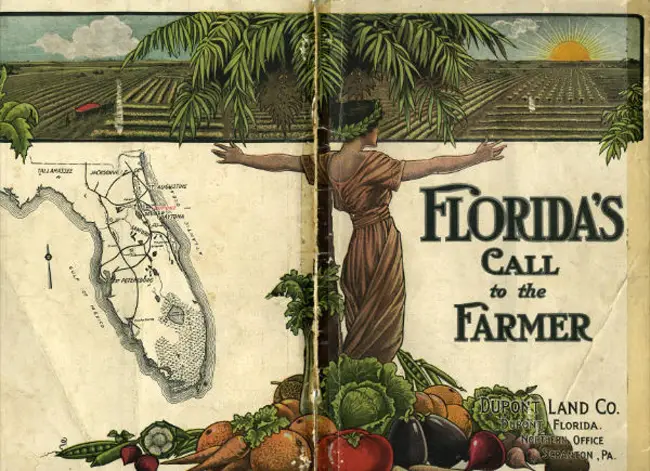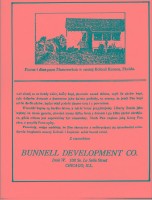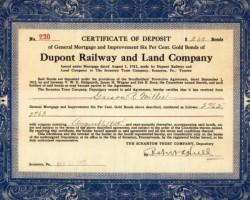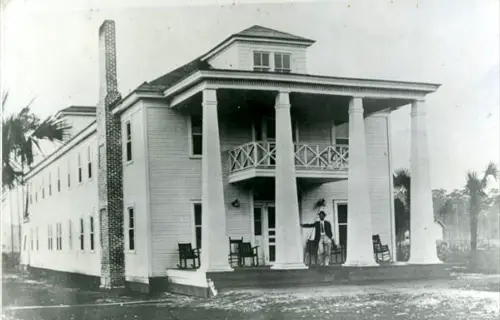
By Sisco Deen
While many of the Flagler County pioneers came to till the land in the early 1900s, some, as most do today, came here for other reasons. The writer’s paternal great-grandfather moved here in 1907 from Bergen County, N.J., for health reason. His daughter married my grandfather who had come here from Appling County, Ga., in about 1902 to operate a turpentine still for his uncle. The rest is, as they say, history.
Click On:
- From Flagler County to Pearl Harbor: James Brazier Booe’s Story
- Holden House and the Old Courthouse: A Grateful Historical Society and an Update
To quote from the printed word, “These are the days of high-soaring prices for food, clothing and shelter. They are difficult days for thousands of salaried employees living in cities; prosperous days for part of the past army of wage-workers, precarious days for the rest. They are days of stress and strain; of wars abroad, of grave anxieties in the homeland.”
This quote is timely but not of recent origin. It was made 99 years ago and appeared in a 23-page booklet published around 1912 by the DuPont Land Company’s Northern Office in Scranton, Penn. The booklet, entitled Florida’s Call to the Farmer, was one of the marketing tools used by the company to sell land in present-day Flagler County to farmers from the North and West.

Noted in the foreword of Florida’s Call to the Farmerwas the “fact” that many farmers in the West and North were considering a change in location. The foreword went on to say: “Their eyes are turning toward the south and Florida, where winter is but a word and farm work proceeds almost continuously throughout the year; where blizzards are unknown and the incomparable climate of Florida reduces living costs and makes living delightful; where farming pays high dividends on a smaller investment of money, time and effort that any other section ……”
Scatted throughout the book were photos of the area that included crops in the field, drainage canals, homes, carloads of potatoes on a rail road siding, the large mill at Dupont and folks fishing on Lake Disston.
“The text,” the foreword continues, “is a straightforward presentation of the facts without coloring and will, we trust, be read with care by the hard-pressed salaried man of the city as well as by the Northern farmer weary of struggling with a worn out farm, with its short growing-season, followed by long idle, miserable months of snow, ice and sleet.”
The DuPont Land Company owed approximately 30,000 acres of agricultural land in the Haw Creek section of Volusia, now Flagler County, exclusive of 720 acres of non-agricultural land in and about the town of DuPont, formerly in St. Johns, now in Flagler.
Lots sold for $100 per acre with $25 down, with payments stretched over three years.

The DuPont Land Company, like ITT in later years, offered prospective land buyers a place to stay while they traveled to present-day Flagler County to take a look at the land. It wasn’t a Sheraton Hotel on the ocean, but rather the company’s sixteen-room (some equipped with private baths) hotel overlooking the railroad tracks in Dupont, some six miles south of Bunnell on U.S. 1. Rates were $2.50 a day, American Plan, with special rates for prospective land buyers.
Since there were no major roads leading to Flagler, most prospective land buyers arrived by train on Henry Morrison Flagler’s Florida East Coast (FEC) Railroad.
The DuPont Land Company wasn’t the only developer attempting to bring in buyers from the northern states in the early 1900s. Some of the other companies included:
The St. Johns Development Company. It held its first meeting at Omega (present-day St. Johns Park) in December 1908. Company officials contracted with the Ben Levin Advertising Agency of Chicago to promote their company in northern newspapers. The St Johns Development Company also had a hotel for guests, most of whom arrived by steamboat coming south from Jacksonville on the St Johns River to Palatka, then southeast on Dunn’s Creek to present-day Crescent Lake, then across the bottom of the lake to Dead Lake and up to the landing at St. Johns Park.

The Bunnell Development Company. Chartered in June 1909, it had offices in Bunnell and Chicago. In December 1912, the Chicago office began publication of a monthly house organ entitled “The Bunnell Home Builder.” The slogan in the masthead read, “The Truth about Florida.” The publication was sent to all Bunnell-Dupont Colony land owners and others who were interested in “securing homes in the Sunny Southland.”
Polish immigrants in Chicago, Detroit and other cities, recent arrivals in this free land of ours, were told of a fabulous land called Florida through polish-language editions of “The Bunnell Home Builder.” The land promotion gimmicks of 99 years ago were employed to spin tales of three crops a year, no snow or ice and ideal farming conditions. The price per acre was $35.
While ITT in later years used passenger airplanes to fly prospective buyers here, the Bunnell Development Company used a special chartered train they called “The Dixie Flyer” for the same purpose. Round trip, Chicago to Bunnell, was $41.89.

Like the other developers, the Bunnell Development Company also had a hotel. It was originally called The Bunnell Hotel and later the Halcyon; this relic of the past still stands today on the corner of Railroad and Lambert Streets. Its windows are boarded and it is surrounded by a chain-link fence. The hotel could accommodate 75 guests who paid $3 per day. The less affluent could stay at the Pine Grove Inn on the northeast corner of Church Street and Moody Blvd. (the now vacant lot to the east of the Holden House) at $2 per day.
The Ocean City Improvement Company. It was chartered in June 1921 in Ocean City Beach (present-day Flagler Beach) to “develop Ocean City Beach by building streets and sidewalks and other dwellings, hotels … and other things for the beautification of one the finest town sites along the east coast of Florida……” Not mentioned in the charter was the goal of selling land and making money. But that was what the company was about.
The two hotels build in Flagler Beach by the company or one of its principals are now gone. One was located on the site where the Farmers’ Market now functions on weekends (Moody Blvd and Central Ave.) and the other was located across from the pier, where the Bank of America now stands.
![]()
Cal Massey, staff writer for the Daytona Beach News-Journal, wrote an excellent story, Making Tracks to DuPont, on a related subject in December 2008.
Sisco Deen is the archive curator for the Flagler County Historical Society and FlaglerLive’s historical adviser.





























Orion says
Does anyone have knowledge of just why the name was changed from Ocean City to Flagler Beach? Amazing how, there could be “special rates’, when the normal rate was $2.50./night
Kendall says
Thank you Sisco! I would love the opportunity to hear more about the history of Flagler County!! Keep it coming!
Jim Guines says
I think Flaglerlive is on to something by highlighting the history of Flagler. I hope this a continuing feature.
tulip says
Great history story–enjoyed reading it!!
Colleen Conklin says
This was a wonderful and interesting read! Thank you!
Rob Creal says
In 1923 the Post Office was moved from west of the Intracoastal Waterway to the beach side. They wanted to call it Ocean City Beach but the Post Office Department said the name was too long and easily confused with Ocean Cities in Maryland and New Jersey. George Moody suggested the name Flagler Beach. Flagler County had been formed from parts of St. Johns and Volusia Counties in 1917.
Sisco Deen says
Hi Orion,
Rob is absolutely correct but allow me to expand a bit:
During the early days of development of present-day Flagler County, there was a settlement called Ocean City on the west side the intracoastal canal located in the vicinity of Lambert Avenue immediately north of the current bridge.
I have been unable to find when the settlement was established, however, I would imagine it was around 1913 when the Austine Vanburen Wickline family moved there. Catherine Wickline Wilson, granddaughter of A. V., in her book, “A New Beginning, A Picturesque History of Flagler Beach,” states: “…… in 1913, a graded and shelled road was completed from Hastings through Espanola and Bunnell to the little settlement now called “Ocean City.”
When development on the east side of the canal began around 1914, the settlement on the beach side became known as Ocean City Beach.
The following story appeared in the Thursday, August 2, 1923 edition of The Flagler Tribune:
“According to authoritative statement, the name Ocean City Beach has been changed to Flagler Beach, and it is quite likely a post office will be established there by the U. S. authorities. At any rate a petition has been filed by the residents of that thriving little city, signed by some seventy odd persons, asking that such a step be taken, and we are informed that this has been favorably considered by the post office department.
Flagler Beach shortens up the name somewhat, which, from a standpoint of convenience is in line with the desire of the postal authorities, and at the same time seems to be more appropriate than the longer name. Ocean City is the name of the little settlement on the canal, which already has its post office.”
If you are interested in seeing what Flagler Beach looked like in the “old days,” you can purchase a copy of Catherine’s excellent book at either the Flagler Beach Museum, 207 S. Central (open 10-4, Monday through Saturday) or the Holden House Museum in Bunnell, 204 E. Moody Blvd.(across the street from the old courthouse; open 10-1 on Wednesdays).
Sisco Deen says
Back to the drawing board – Thea Hein Mathen donated to the Flagler County Historical Society today (05 Jan 2011) a copy of the SOIL SURVEY OF FLAGLER COUNTY, FLORIDA by Arthur E, Taylor, which was printed by the Government Printing Office in 1922.
There is entry on the cover noting that the report was from “Advance Sheets – Field Operations of the Bureau of Soils, 1918.”
Attached to the report that is dated 1918 is a beautiful color map signed by W. Edward Hearn, Inspector, Southern Division; Soils surveyed by Arthur E. Taylor.
The long and short of it, is that the settlement on the coast east of Ocean City on the west side of the intracoastal canal is named “Atlantic City” on the map.
In the body of the report it states that “there are many farms along the Brick Road (Dixie Highway) between Espanola and Ocean City …..”
A paragraph later it states: “Atlantic City is both a summer and winter resort.”
So, was it Ocean City Beach or Atlantic City before it became Flagler Beach?